How to install heating meters in an apartment: installation of individual devices
It is impossible to live in unheated rooms in winter and no one argues with this.Hot radiators during the colder months are a common benefit of modern life. However, the bills regularly calculated by heating management specialists are often inflated, aren’t they?
Have you decided to figure out how to install heating meters in your apartment in order to get a real chance not to pay extra, but don’t know where to start?
We will help you study this issue in detail - the article describes the procedure for installing a meter and the interaction of the owner with the heat supply organization. The main types of meters and their features are also discussed.
The article is supplemented with thematic photos and useful video advice from owners who, through the courts, proved their right to pay only for the heat actually consumed.
The content of the article:
- Purposes of installing a heating meter
- Monthly payments for someone else's living space
- Types of residential heating system wiring
- Features of the main types of meters
- The procedure for legal installation of a heat meter
- When is installation impossible or unprofitable?
- Conclusions and useful video on the topic
Purposes of installing a heating meter
Heating a house is expensive. But private homeowners at least have a choice of boiler equipment and fuel. Residents of high-rise buildings have no choice - central heating with tariffs set by the management company.
However, there is a tool for reducing apartment heating costs - an individual heat meter.
When there is no high-quality heating, it happens that malfunctions of the home heating network force you to look for alternative heat sources.
Or the cause of cold room radiators is the intention of the management of the housing office to save on general heating costs.
Then the plumber tightens the stop valve, reducing the flow of hot water in the heating network of the high-rise building. Residents get cold and warm heaters, increasing electricity bills. But this does not reduce the cost of heating.
Do you also have to freeze in your apartment? We invite you to view information about insulation of apartment walls, discussed in our other article.
When there is too much heat, the overheated air in the rooms is unpleasant, you have to open the window to lower the overall temperature level. But behind the seemingly simple methods there is money spent on “heating the street.”
You can save them by installing regulators for heating batteries and a heat meter - for the heating circuit of the apartment.
You may also be interested in information about comfortable temperature standards in residential premises, which you can read about In this article.
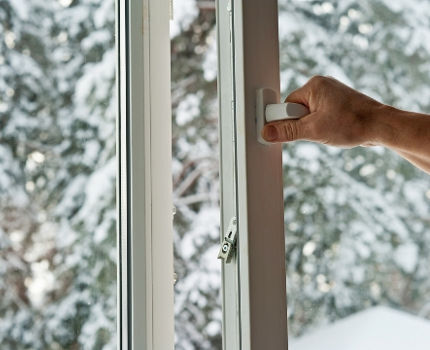
There are also hidden components of heating payments. This is when the coolant from the boiler room enters the main networks at one heating temperature, but at the entrance of the heating pipes into the house its temperature is different, lower.
The delivery of coolant through pipes is accompanied by heat loss due to poor insulation, this is understandable. But these heat losses are paid by the end consumer - owners of apartments in high-rise buildings that are not equipped with heat meters.
Monthly payments for someone else's living space
Each apartment building must be equipped with a heat meter - Article 13, paragraph 5 of Federal Law No. 261-FZ of November 23, 2009.
The management company fulfills this condition and, based on the results of each month, records the heat consumption for the high-rise building under its management.
The amount for thermal energy is simply divided between apartments according to their living space. Although this approach cannot be fair.
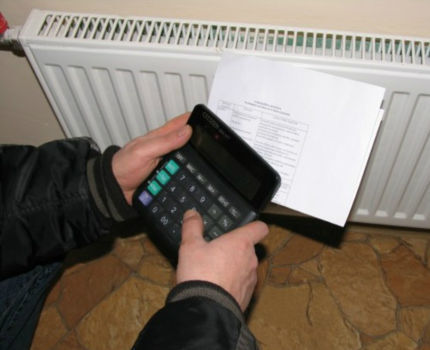
The data on living space available in the Criminal Code are based on the technical passport of each apartment. However, such technical data sheets often do not take into account data on apartment redevelopments that increase the heating area.
It does not contain information about increasing connection points for heating radiators.
Meanwhile, apartments with redevelopment and an expanded number of heating devices consume more heat than others.
And since the general building consumption of thermal energy is divided according to the registered living space, residents of “ordinary” apartments pay for the heat consumed by residents of “improved” apartments.
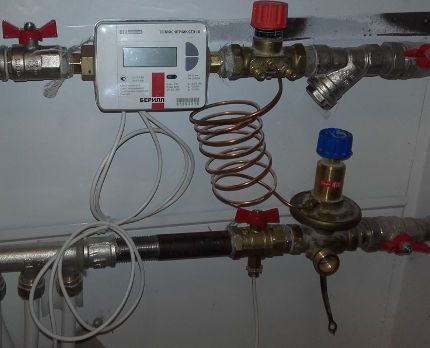
A simple way out of the situation with paying for someone else’s heat is individual meters on the heating circuits of apartments.
Cost savings on thermal energy, the consumption of which is determined by a heat meter, will amount to over 30% of previous heating payments tied to the size of the living space (standard).
Types of residential heating system wiring
Apartments in high-rise buildings are equipped with either vertical or horizontal distribution of the heating system. In apartment buildings built before the beginning of the 21st century, heating systems were installed vertically.
Option #1 - vertical wiring
The vertical circuit of the thermal system is made of one pipe, less often two pipes.But always with a sequential flow of coolants through the interfloor levels - from bottom to top, then from top to bottom.
Vertical heating distribution is especially common in Khrushchev-era buildings.
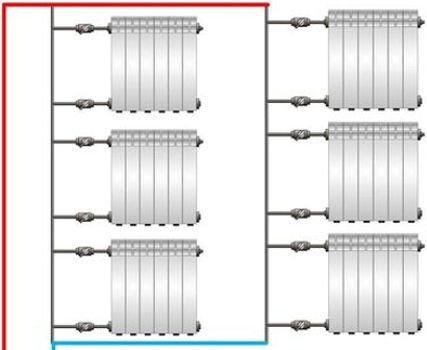
Heating with vertical wiring has serious disadvantages:
- Uneven heat distribution. The coolant is pumped along a vertically oriented interfloor circuit, which does not ensure uniform heating of rooms at different levels. Those. in apartments on the lower floors it will be noticeably warmer than in rooms located closer to the roof of a high-rise building;
- Difficulty adjusting the heating level heating batteries. The need to equip each battery with a bypass;
- Problems with balancing the heating system. The balance of single-circuit heating of vertical distribution is achieved by adjusting shut-off valves and thermostats. But at the slightest change in pressure or temperature in the system, the adjustment must be made again;
- Difficulties with individual heat consumption metering. There is more than one riser in the vertical heating system of apartment rooms, so conventional heat meters cannot be used. You will need several of them for each radiator, which is expensive. Although for vertical heating, another thermal energy metering tool is available - a heat distributor.
Constructing a vertically oriented heating pipeline was cheaper than horizontal wiring - fewer pipes were required.
Such savings in the era of mass standard development of urban areas of Russia in the 20th century were considered completely justified.
Option #2 - horizontal wiring in a high-rise building
When the heating system is laid out horizontally, there is also a vertical supply riser that distributes the coolant across the floors.
The pipe of the second riser, which serves as a return line, is located in a vertical technical shaft next to the supply riser.
From both distribution risers, horizontal pipes of two circuits are led into the apartments - supply and return. The return line collects cooled water, transporting it to a thermal station or heating boiler.
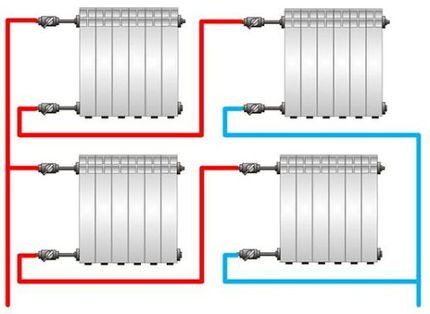
The advantages of horizontal distribution of heating pipes include:
- possibility of adjusting the temperature in each apartment, as well as throughout the entire highway (installation of mixing units is required);
- repair or maintenance on a separate circuit heating without completely shutting down the heating system. Shut-off valves allow you to close the apartment’s circuit at any time;
- quick start of heating on all floors. For comparison, even in a well-balanced single-pipe vertical distribution system, delivery of coolant to all radiators will take at least 30-50 seconds;
- installation of one heat meter per apartment circuit. With horizontal heating distribution, equipping it with a heat meter is a simple task.
The disadvantage of a horizontal heating circuit is its increased cost. The need to install a return pipe parallel to the supply pipe increases the price of residential heating by 15-20%.
Features of the main types of meters
A group of individual heat energy metering devices is designed to work in heating networks with a pipe channel diameter of 15-20 mm and a coolant volume in the range of 0.6-2.5 cubic meters per hour.
Heat meters and heat distributors perform calculations of consumed thermal energy independently, with data displayed on an electronic display.
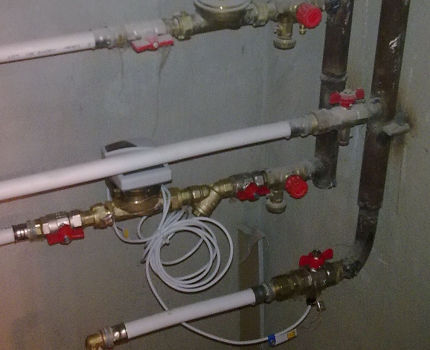
The computing module of the device determines the amount of heat consumption for a given period of time (hour, day or month), storing and accumulating this information in the device’s memory for 12-36 months.
The most convenient way is to install a non-volatile heating meter (i.e. with an additional power source - a battery).
Depending on the heat meter model, its measurement values are displayed as kilowatts per hour, megawatts per hour, gigajoules or gigacalories. Management and other utility companies require heat readings in Gcal.
To convert to gigacalories, you must apply the appropriate conversion formula. For example, for kilowatts per hour - multiply the value by a factor of 0.0008598.
Each meter is a complex of several devices. Its kit may include temperature sensors, calculators for the volume of consumed thermal energy, as well as pressure, flow and coolant resistance transducers.
The exact configuration of the heat meter is set by the manufacturer for a specific model.
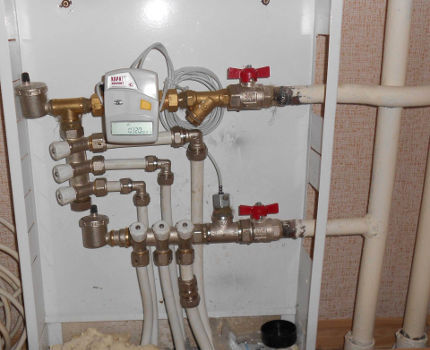
Depending on the principle of accounting for consumed thermal energy, heat meters are equipped with an ultrasonic or mechanical (tachometer) flow meter.
Models of devices with other types of flow meters (for example, vortex or electromagnetic) are also available, but they are not widely used. Heat meters are designed to collect information on heat consumption exclusively on the horizontal distribution of the heating circuit.
A separate group of heat meters are calculators and heat distributors that do not require insertion into the heating circuit. These devices are used to calculate the heat costs of heating radiators for any heating circuit diagram.
Type #1 - mechanical version of the flow meter
The simplest type of design, therefore the cheapest (about 9,000-10,000 rubles) is a device with two wired temperature sensors, a water meter and an electronic computer unit.
The main working element of the meter is a part (impeller, turbine or screw) that rotates as coolant passes through the device. The number of rotations determines the volume of coolant passing through the meter.
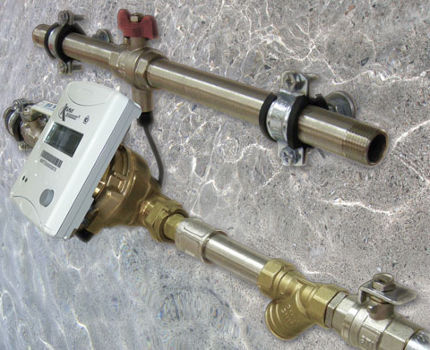
Contact thermometers are built into the supply and return pipes of the heating circuit of the apartment. The first thermometer is placed in the meter, in a special socket.
The second is installed on the return pipeline, in a ball valve of a special design (with a socket) or in a tee equipped with a sleeve for a thermometer.
Advantages of mechanical heat meters:
- cost about 8,000 rubles;
- the design is simple and reliable;
- no external power supply required;
I am attracted by the fairly correct stability of the indicators and the permissibility of installation in a horizontal or vertical position.
Disadvantages of mechanical type heat meters:
- guaranteed work period no more than 4-5 years — verification is required every 4 years;
- high wear of rotating parts - however, all mechanical meters are repaired for little money;
- increase in pressure — the rotating element helps to increase the pressure in the heating circuit;
- susceptibility to water hammer;
- high need to match the actual coolant flow in the heating system to the nominal flow rate established by the manufacturer.
It is mandatory to integrate a coarse magnetic mesh filter into the circuit in front of the mechanical heat meter. The device is extremely sensitive to the content of mechanical suspensions in the coolant volume!
Type #2 - ultrasonic heat meter
These devices determine the coolant flow using an ultrasonic signal emitted by the emitter and received by the receiver.
Both elements of the thermal ultrasonic meter are mounted on a horizontal heating pipe, and a certain distance is established between them.
The signal from the emitter follows the coolant flow and reaches the receiver after a period of time depending on the speed of the coolant in the heating circuit. Based on the time data, the coolant flow rate is determined.
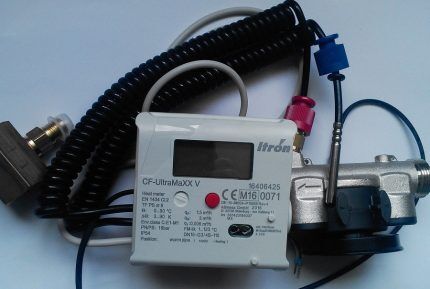
Over 10 versions of ultrasonic flow meters are produced - frequency, Doppler, correlation, etc.In addition to performing basic tasks, an ultrasonic heat meter can have the function of adjusting the flow of coolant.
Advantages of ultrasonic heat meters for apartments:
- low price in the basic configuration - from 8,000 rubles. (domestic models);
- heat consumption data is displayed on the LCD display by pressing one button, which is convenient;
- operation of the device does not cause an increase in hydraulic pressure in the heating system;
Significant advantages include a long service life - more than 10 years (verification is necessary every 4 years) and power supply from a built-in battery.
The main disadvantage of ultrasonic heat meters is their sensitivity to the composition of the coolant. If it contains air bubbles and dirt particles (scale, scale, etc.), the device readings will be incorrect, and in the direction of increasing heat consumption.
For ultrasonic flow meters, there is one installation rule - the section of the pipeline in front of and after the device must be straight (the required total length of the straight section is more than a meter). Then the meter will provide correct data on heat consumption.
Type #3 - calculator and heat distributor
These devices measure the relative costs of thermal energy. Their design includes a thermal adapter and two temperature sensors.
Every three minutes, sensors measure temperatures on the surface of the heating radiator and in the room atmosphere, determining the difference. The collected information on heat consumption is summarized and displayed on the device screen.
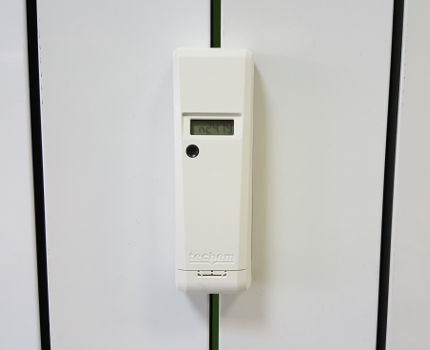
Heat computers are programmed to operate on a specific type of heating radiator at the time of installation on it.
You may also be interested in information about the types of heating radiators and their characteristics, discussed in our other article.
All necessary coefficients and power indicators of the radiator are entered into the meter’s memory, which allows it to display data on heat consumption in kilowatt-hours.
The numbers indicated by heat distributors are displayed in conventional units. To convert them into kilowatt-hours, you should multiply the value of the readings by the rated power of the heating radiator and the coefficient corresponding to the type of heating battery.
The coefficient numbers are provided by the meter manufacturer based on the results of laboratory tests.
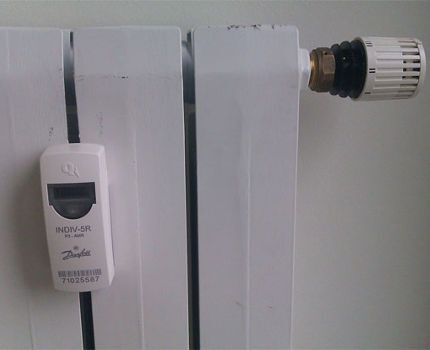
Calculators and heat distributors are placed to measure thermal energy on one heating radiator. Those. in an apartment where heating is metered using such devices, there should be as many meters as there are heating radiators.
Both types of meters are effective regardless of the residential heating scheme and the operating characteristics of the coolant used in the heating circuit.
Advantages of heat distributors and calculators:
- cost is about 2000-2500 rubles. - i.e. their installation is beneficial in small apartments equipped with five heating radiators or less (but more than 2);
- long service life without verification - 10 years;
- simple and quick installation on or next to the radiator housing;
- transfer of data from several heat meters via radio to a single controller that sums them up (the presence of a radio module depends on the device model);
A convincing argument in favor of installing such devices is the complete independence of measurement results from the quality of the coolant.
Disadvantages of apartment computers and heat distributors:
- the relative measurement error is up to 7-12% (the greatest error is characteristic of heat distributors), which is higher than that of “mortise” heat meters;
- Energy consumption data is correct if calculated from the results of measurements of several devices within the apartment. One computer is not able to correctly determine the heat consumption of the atmosphere from one radiator. Summary data across multiple instruments is required;
- Effective operation only on factory models of heating radiators. Those. any modifications to the factory configuration of the radiator when measuring heat with such heat meters are unacceptable.
The installation kit for installing a calculator or heat distributor is selected according to the type of radiator on the body of which the meter will be installed.
Handicraft methods of installing the meter will worsen the quality of data collection. If there is no specialized mounting kit, it is more rational to mount the device next to the battery it serves.
The procedure for legal installation of a heat meter
The sequence of actions aimed at installing an individual heat metering device in an apartment consists of several stages.
Let's look at them in more detail:
- Written appeal to the house management organization for permission to install a heat meter. Copies of documents on ownership of the living space and the technical passport of the apartment must be attached to the letter.
- Obtaining technical specifications for installation of a heat meter at a heat energy supplier (usually a management company).
- Project preparation individual heat metering and installation technical documentation. Performed by an organization that has the legal right to provide design services.
- Approval of project documentation with the heat supply company.
You should not purchase a heat meter before receiving an agreed upon thermal energy project, because Failure is possible for various reasons.
Having all the documentation for the project, all that remains is to choose a heat meter - ultrasonic, mechanical or externally installed, for example, a heat calculator.
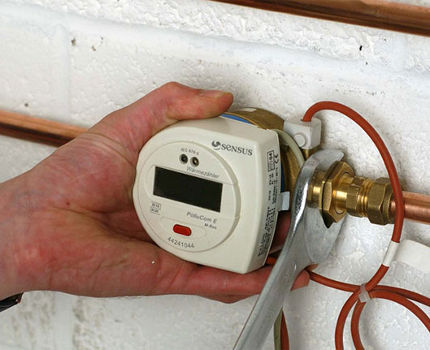
For the purchased model, you must obtain from the seller receipts (sales and cash receipts), instructions, warranty card and a copy of the current quality certificate.
The company installing the heat meter must have a license for this type of work.
Before choosing a contractor, it is necessary to evaluate the data on the candidates (Unified State Register of Legal Entities, certificates, SRO approvals), the professionalism of the installers (special equipment, list of installation work, availability of an installation kit), guarantees of the work performed.

Please note that in addition to the heat meter, you will need additional devices and accessories: bypass, radiator thermostats, pipe filters, tees, etc.
Sealing the heat meter or heat distributor after installation work is mandatory.
The seals are placed by representatives of the heat supply company.
When is installation impossible or unprofitable?
The management company will refuse to install an individual heat meter if there is no common house heat meter. To calculate the ODN coefficient, you need to know the heat consumption of the entire house.
Payments for a heat meter in the following situations will be higher than without it:
- the entry of the heating main into a multi-storey building was carried out according to an outdated scheme - through an elevator;
- the apartment is located at the end of the house, on the top or first floor;
- there are gaps in the window frames and in the front door frame;
- the loggia (balcony) is not glazed - in such a situation it can help insulation of the balcony;
- drafty entrance area (broken windows, ajar entrance door), etc.
Note that to minimize heat energy costs, it is not enough to install a common house and apartment meter. It is necessary to modernize the heating system of the building - replacing the elevator unit with AITP or AUU.
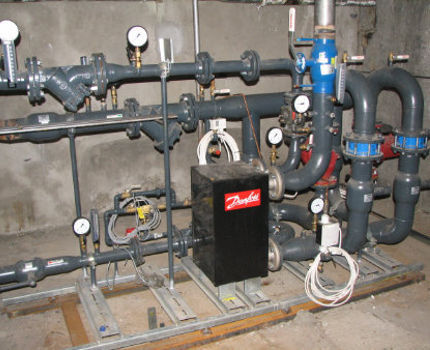
Only in such a high-rise building energy system will it be possible to achieve comfort in apartments with minimal heating payments.
Conclusions and useful video on the topic
Installation of a heat meter is a requirement of Russian legislation. But this rule does not apply to apartments in high-rise buildings.
The reasons why there may be problems with individual heat meters are discussed in this video:
In 2013, a St. Petersburg resident installed heat calculators on the radiators in his apartment and became convinced of a 30% overpayment for heating.
But ZhSK-3 is in no hurry to compensate for his expenses. Watch the video:
Legislation requires that the heating network in a high-rise building be equipped with a house meter, but only a common one (for the whole house).
And for managers of multi-apartment households Individual meters are beneficial in the only case - if the house is new or reconstructed (thermal insulated) according to modern standards.
Have you installed a heating meter for yourself or have valuable information on this issue that could be useful to our other readers?
Perhaps your experience will help solve a difficult situation or inspire you to actively fight with the heat supply company. Share your story or ask questions on this topic - leave your comments under this article.




The question of installing a heating meter just arose. In the apartment in which we now live, the heating system is vertically installed, the heating is strong, and we have to open the windows, and the bills for heat come up huge. We recently purchased an apartment, half of the house has already been rented out, and ours is only six months away. There is a horizontal heating distribution and we want to immediately install a heat meter. I don’t want to pay for the heat released through the window, but I’m afraid the Criminal Code won’t give permission for some fictitious reason.
Lovista, submit an application to the housing and communal services department, don’t be afraid. Then submit the documents to the court, and you will be right. But it’s better to have neighbors with you. But there are savings, I know from my own experience. The main thing is patience.
Vasily, what 30% are we talking about? Don’t mislead people, in order to save even a little, you need at least: automation in the heating system, warm walls, PVC windows. I am silent about the 75% consent of neighbors and thermostats. Who needs it? Your IPU in a separate apartment?
Hello. Temperature standards exist at both lower and upper limits.It doesn’t matter what kind of wiring they have, you could easily file a complaint if they are exceeded.
As for doubts about permission for a meter in horizontal wiring - you have every right to an IP, demand permission, motivate it by the fact that Federal Law of the Russian Federation of November 23, 2009 N 261-FZ orders all homeowners to install both general building energy meters and apartment meters for water, electricity, gas, and, if technically possible, apartment heat meters.
Yes, only for violation of Article 13 of this law there is no liability.
I was also touched by this issue. We recently completed the construction and finishing of a private house for a family, and now it’s time to install individual heating meters in the house. There are many places where the structure and sequence of actions in installing meters are described, but we still turned to specialists and did without doing it on our own.
I live in an apartment building. The house is brick, and for most of the heating season, the radiators in the apartment are turned off, because it is warm without heating. Question: when the battery in the apartment is cold, will the readings be zero, and therefore the payment during this period will be 0?
Evgeniy, if the radiators are cold, then you don’t pay for heating. But the mechanical meter will still record the movement of the cold coolant and calculate the payment.
If the radiators are cold, you don’t pay for heating the apartment; for some reason you are silent about paying for one. What kind of movement of cold coolant are you writing about in a disconnected radiator, where there is no circulation?
Hello. The heating meter does not count the amount of movable coolant, but the supplied resource. The only problem with summer payment is if the meter does not function due to reasons such as the expiration date has expired, deteriorated, seals have been broken, and so on. Then the homeowner can be charged according to the standard at any time of the year.
Good afternoon. Apartment in Khrushchev, vertical wiring, four radiators. If you install apartment calculators or heat distributors on all radiators and shut off the coolant supply to these radiators, and heat the room using electric convectors, will the payment for heating when the coolant is turned off be zero? Thanks in advance for your answer.
Good evening! Tell me, is it possible to install individual heating meters on a vertical heating system? I have 6 drains in my apartment, and in general, I have individual heating. Maybe it will be possible to pay according to the meters, and not the entire amount for central heating. Nowadays the heating network has this practice: you don’t have heating, but you have to pay. Thank you.
According to PPRF regulations No. 1708, meters for measuring thermal energy can now be installed in any apartment. The regulation came into force on December 28, 2018. The meters are mounted on both vertical and horizontal heating systems.
For heating circuits with horizontal wiring, the meter is mounted on the supply line, and the return pipe is equipped with a three-way valve with a temperature sensor.
In our apartments, heating is mainly arranged with overhead wiring, i.e. The coolant enters the radiators through vertical risers.In this case, a heat calculator is installed on each device, which is programmed for this particular radiator.
Good afternoon. I just talked to my management company. The chief engineer said that in order to receive readings from heat meters, it is necessary that all apartments in an apartment building be equipped with them. No one will issue an invoice to me individually. At the same time, the house is equipped with a collective metering device (its own substation). Is it so? Or get an official refusal and file a lawsuit? Thank you.
Hello. I will quote you the norm - Decree of the Government of the Russian Federation dated 05/06/2011 N 354 (as amended on 05/22/2019) “On the provision of utility services to owners and users of premises in apartment buildings and residential buildings”:
«VI. Procedure for calculating and paying utility bills:
3(1). The amount of payment for utility services for heating in the i-th residential or non-residential premises in an apartment building, which is equipped with a collective (general house) heat energy meter and in which at least one, but not all residential and non-residential premises are equipped with individual and (or) common (apartment) heat energy metering devices, in accordance with paragraphs 42(1) and 43 of the Rules, is determined by the formula: (see attached image).
Where:
Vi is the volume (quantity) of thermal energy consumed during the billing period per room i (residential or non-residential) in an apartment building and determined in the i room (residential or non-residential), equipped with individual and (or) common (apartment) metering devices, when paying for utility services for heating during the heating period based on the readings of an individual and (or) general (apartment) metering device, when paying evenly throughout the calendar year - based on the average monthly volume of thermal energy consumption for heating, obtained on the basis readings of an individual and (or) general (apartment) metering device for the previous year, and in the i-th room (residential or non-residential) in an apartment building not equipped with individual and (or) general (apartment) metering devices - based on the area of such premises according to formula 3(7);
Si is the total area of the i-th room (residential or non-residential) in an apartment building;
Vd - the volume (quantity) of thermal energy consumed during the billing period in an apartment building, determined when paying for utility services for heating during the heating period based on the readings of a collective (common house) heat energy meter, and when paying evenly throughout the calendar year - based on from the average monthly volume of thermal energy consumption for heating in an apartment building based on the readings of the collective (common building) heat energy meter for the previous year;
Sob - the total area of all residential and non-residential premises in an apartment building;
TT - tariff (price) for thermal energy, established (determined) in accordance with the legislation of the Russian Federation.
«.And ask the management company why they approved the installation of the meter and put it into operation if they did not plan to take it into account?
Hello! In accordance with this formula, it makes sense to install an IPU if it is installed in more than 50% of apartments - that’s what the management company told me, they even calculated it. They said that in addition to the IPU data, in accordance with the formula, they will also have to pay for the DPPU indicators as a percentage (apartment area). Is it so? Thank you!
Good afternoon. This is a question: I live in an apartment building, there is a communal heat meter, can I install individual heat meters in my apartment alone? How to do it? Who do you need to coordinate with? In general, is this possible or is it necessary for all apartments to have individual heat meters installed?
Federal Law of the Russian Federation dated November 23, 2009 N 261-FZ requires, by January 1, 2012, all homeowners to install both general house energy meters and apartment meters for water, electricity, gas, and, if technically possible, apartment heat meters .
Decree of the Government of the Russian Federation dated 05/06/2011 N 354 (as amended on 05/22/2019) “On the provision of utility services to owners and users of premises in apartment buildings and residential buildings”:
«Rights and obligations of the consumer:
h) make a decision on the installation of an individual, general (apartment) or room metering device that complies with the requirements of the legislation of the Russian Federation on ensuring the uniformity of measurements, including a metering device whose functionality makes it possible to determine the volumes of consumed utility resources differentiated by time of day or other criteria , reflecting the degree of use of communal resources, even if such an individual or common (apartment) metering device differs in functionality from the collective (general house) metering device with which an apartment building is equipped, and apply for the installation of such a metering device to the persons carrying out the corresponding Kind of activity
«.Agreement procedure:
1. Write an application to the Criminal Code for an inspection report on the technical capabilities of installing the IPU.
2. Select a meter in accordance with standards and GOST.
3. Contact a specialized company (you can contact a resource supply company or management company if there is a full-time electrician with the appropriate license).
4. Carry out an inspection and measurement report for the installation of the IPU.
5. Get the installation project.
6. Coordinate the project with the management company.
7. Install the meter with the help of specialists.
8. Write an application for commissioning and sealing.
Good luck!
Good afternoon I bought an apartment on the first floor, it was very cold. The batteries are practically cold, there is not enough pressure in the batteries, they are added only in severe frosts. If I install a heat calculator, I’ll probably stop paying for heating altogether. The temperature of the batteries themselves at the entrance is now 22 degrees, and then they are generally cold. What should the battery inlet temperature be? Thank you.
Hello. Temperature standards for rooms in apartment buildings are prescribed in GOST R 51617-2000. Housing and communal services. General technical conditions (with Amendment No. 1) and SNiP 2.08.01. If there is a discrepancy, you have the right to submit an application for an inspection report and examination, as well as file a complaint and demand a recalculation of payment.
Vertical wiring is the most optimal for owners. It is convenient to monitor the condition, and everything is under control directly in the apartment (as in photo 1).
And horizontal - you pay for heating the floors in the entrance and apartment, i.e. Until the heat reaches the battery there will be nothing to heat it with. Also, access to the IP is located on the floor and it is not possible to identify the IP apartment by apartment, except by checking the code. Also, the management company has the practice of dismantling the IPU (photo 2) so that payment is made according to the same payment method.
Hello Andrei. I would like to take a look at the specific link for your example. The management company has no right to dismantle an officially approved IPU without permission. It will be interesting to look at the rationale behind this decision.
“Until the heat reaches the radiator there will be nothing to heat with” - this is a question for SNIPs, GOSTs and sanitary standards. There are established temperature rules; violating them is illegal and faces sanctions. You just need to fuss once and punish the culprits, so that you can sit quietly throughout the heating seasons in warmth and comfort.
“Also, access to the IP is located on the floor and it is not possible to identify the IP apartment by apartment, except by checking the UC” - IPU is an individual metering device. What does it mean - located on the floor?
Describe in detail what is happening there, maybe we can help with some advice.
Tell me, at what distance to the battery should the IPU be installed according to SNIP in an apartment building with horizontal wiring?
It's warm in the hallway, cold in the apartment. We pay for one, although there are no batteries in the house or entrances; more precisely, when we accepted the house, there were batteries, but they were so disguised that when they were removed, the pipes were left without traces of connection! Thank you.
Hello. ONE is not only an entrance. SanPiN 2.1.2.2645-10 Sanitary and epidemiological requirements for living conditions in residential buildings and premises (as well as GOST 30494-96. Residential and public buildings. Indoor microclimate parameters): permissible air temperature standards in the lobby, on the staircase: 14–20°С.
It makes sense to ask the management company about the torn radiators.
Good afternoon Tell me, if our house does not have an IPU and the management company cannot supply it, because... Technical conditions do not allow it, can I install a heat meter on each battery in my apartment? When communicating with the chief engineer of heating systems, they said that no, I can’t. In short, as always, we have one task: PAY...
Hello. Tell me, what exactly motivates the engineer’s refusal?
If the house has an ODPU (Common House Metering Device), then it makes NO SENSE to install an individual one from 2018, now:
- those who have a meter in their apartment (IPU) - pay according to the meter;
– those who don’t have a meter pay like the average meter owners, but they don’t have to spend money on installing a meter and can spend as much heat as they want.
Formula 3(7) in Decree of the Government of the Russian Federation dated May 6, 2011 No. 354.
Sergey, how will you speak when your supply temperature is 22 degrees, as in the comments above? You can spend as much heat in cold water as you like, and pay like the average owner.
Do you understand what we're talking about? IPU always calculates the heat consumption in the apartment, and only that, and not the average for such cunning people as you :) Therefore, there is no point only for “not very wise” people who are ready to open all the windows wide, if only their neighbor would pay for it :)
Good evening! The problem is not new, but still: we live in a five-story apartment building, a corner apartment on the fifth floor, but everything might have been normal if not for the actions of the chairman of the HOA to constantly limit the heat supply to the house. You see, it’s asked by tenants whose apartments are hot and want to save money. It may be hot here, but we pay to comply with the standard of 18 0C 20 0C in a corner where the walls are covered with mold, the air simply does not dry out. We can’t help but breathe, cook, wash, and why should we pay for batteries with a temperature of 30 C? A person generates more heat than such a radiator.
We rightly assume that all our possible appeals and complaints will come down to compliance with that same standard, although today we purchased a psychrometer that recorded the humidity in the corner room up to 73%!
We pay for what we don’t get—they save on us. We are flooded by the heater, but why on earth... The tales about problems in the heating system and the “furious” attempts to solve them on the part of the chairman of the HOA are tired, because there are none, there is only his tyranny (I measure the temperature of the radiator at 11.00 - 46 C, in the evening it’s barely barely 30 C).Perhaps as a result we will be forced to settle on the option of installing an IPU, but they say there are cases of refusal to seal them, because they begin to take into account at a coolant temperature of 40 C (this would suit us, just to stop this disgrace).
Has anyone encountered this? Can you also recommend the IPU model?
Hello. Have you measured the temperature of the radiators on the lower floors? Here you generally need to call specialists and check the heating system for illegal connections (for example, heated floors), airing or clogging of the system. Perhaps the reason is simply that they are really hot?
If residents simply want to save money, this is also not a reason to limit the heat supply. There are NORMS and they are within the framework of the LAW (you yourself know this). And not a single neighbor of yours has the right to infringe on your interests in this case. Let them install IPU, what do you have to do with it?
There is no need to come up with IPU, not IPU, here you need to resolve the issue of what you pay for. A complaint to the housing inspectorate should have the desired result and heal your incompetent HOA chairman a little.
But here in Crimea, they charge for the entire 12 months. Explaining this by saying that they are trying for us. They spread it over the whole year so that you pay less per month. They do not allow you to turn off the heating. Even under Ukraine, a resolution was passed banning disconnections from heating. And the heating network in Alushta has not provided hot water for 15 years.
Heating payments are distributed throughout Russia. And if the coolant is not supplied to the apartment, it is necessary to carry out an examination and sue the management company or the one who takes money from you for the coolant.
If your home does not have an ODS installed, then this is the correct calculation. If there is an ODS, feel free to file a complaint, because Payment is made exclusively during the heating season!
And we stopped by an apartment in which the radiators are already equipped with heat regulators. But we rarely turn them on, it’s hot. And we pay like everyone else, per sq.m.
If there is a heat regulator on the battery, then we can install a meter for the consumption of this heat, and they will be charged according to it?
There are no batteries in the entrances at all.
Good afternoon What should I do if the management company responded to a request regarding the installation of thermal energy IPU in my apartment and responded that my apartment has a vertical heating system and in such apartments the installation of thermal energy IPU is not provided?
Please tell me what legislative acts can be viewed to understand the rules for calculating heat using a common house meter in the Nizhny Novgorod HOA
Good afternoon Help with advice! We live in a panel house (as representatives of the management company put it, a large-slot house). New radiators have been installed, but they are of no use...the risers are barely warm. In cold weather it was a little hotter, but not so much that the hand could not stand it.. The house has common metering devices. We want to supply individual ones, we’re tired of paying through the nose for cold batteries and electric radiators. The management company refuses, they say it is impossible to install meters in houses with a vertical heating system. What should I do? How to stop paying for cold batteries? Where to file a complaint?
I am amazed at some of the reasoning. You have moved into an apartment building, and someone else must maintain the house.Why should energy losses fall only on corner apartments and the first floors? How to account for these losses? They are common people. The entrance also belongs to the common property. We installed a common meter at the entrance (we have 12 of them) to prove that heat was not reaching us. Then they sent engineers and redid the circuit, it turned out that we were receiving return flow from all over the house, we were freezing. In general, I think installing apartment meters is an extra expense. They are also purchased for money, sealing is also not free, and installation also costs money. In new houses with horizontal wiring, these meters are already installed. After the warranty, more than 50% failed. No one gives a guarantee that it will not break in 4 years. There are water hammers when starting up, so you need to purchase shut-off valves. Personally, starting heating is terrible for us. You bleed the air, you have to clean the filters in front of the meter. If you can’t do it yourself, wait for locksmiths. You can freeze for up to two weeks or call a locksmith for a fee. Again, expenses. Where is the benefit? Complete madhouse. In neighboring houses where there is vertical wiring there is no such thing.
My daughter has been living in an apartment building in Krasnodar for 4 years. The house is equipped with individual heat energy meters, but the meters are not located in the apartments, but in a separate room on each floor (there are 5 apartments on each floor, in total there are 250 in the house). The apartments have cold and hot water meters. The room where the meters are located for 5 apartments is closed, access is given to the management company and its employees. Yesterday the daughter sent a letter from the management company, with a message that the apartment's heat meter is out of order and must be replaced by the tenant within a month.There are no explanations in the letter about what happened, why the meter only worked for 4 winters, it only indicates the phone number of the person who needs to be contacted to replace the meter. At the time of purchase of housing, all apartments in the building were equipped with metering devices. Please help me figure out how to behave in such a situation?
Yes, only for violation of Article 13 of this law there is no liability.
DECREE OF THE GOVERNMENT OF THE RF OF JULY 31, 2021 N 1295 “ON AMENDMENTS TO THE RULES FOR THE PROVISION OF PUBLIC SERVICES TO OWNERS AND USERS OF PREMISES IN MULTIPLE-Apartment BUILDINGS AND RESIDENTIAL BUILDINGS AND RECOGNITION OF THE TERMS AND CONDITIONS NCTA “D” POLICY 5 CHANGES THAT ARE MADE TO THE ACTS OF THE GOVERNMENT OF THE RUSSIAN FEDERATION, APPROVED BY DECREE OF THE GOVERNMENT OF THE RUSSIAN FEDERATION OF FEBRUARY 27, 2017 N 232″
The rules for calculating heating fees in houses with an individual heating point have been revised.
The government has made changes to the procedure for calculating utility bills. It is brought into line with the decision of the Constitutional Court of the Russian Federation, according to which for houses with an individual heating point, the amount of payment for heating should be determined taking into account the readings of both common house and individual metering devices.
The resolution comes into force on the date of publication.
The Government of the Russian Federation has adjusted the procedure for calculating heating fees in those houses where there is an individual heating point. Now, for them, the amount of payment for heating is determined taking into account the readings of both common house and individual metering devices (Resolution of the Government of the Russian Federation of July 31, 2021 No. 1295).
An individual heating point is a set of technical devices for connecting the city heating network to the communications of a house. As a rule, it is located in the basement. An individual heating point automatically monitors the air temperature outside and, depending on this, increases or decreases the heat supply to the house. For residents, this means a comfortable temperature in their apartments and the ability to avoid overpaying for unnecessary excess heating.
The rules for determining the amount of the fee were changed in connection with one of the decisions of the Constitutional Court of the Russian Federation, which was made in May (Resolution of the Constitutional Court of the Russian Federation of May 31, 2021 No. 24-P). The Court then noted that vague legislation creates legal uncertainty. Thus, instrument readings are taken into account only in houses connected to centralized networks using a dependent scheme. If the house has an individual heating point, and meters are not installed in all premises, the volume of heat is determined by calculation (clause 54 of the Rules for the provision of utility services to owners and users of premises in apartment buildings and residential buildings, approved by Decree of the Government of the Russian Federation of May 6, 2011 No. 354).
Hello! The house was built in 1971, there is no technical possibility to install a common house heat meter. In this case, can I install a heat meter in the apartment?
Hello. I live in the far north. We have a heat bill all year round, although the heat supply is stopped from June to October. In old houses (5 floors), they are approximately 15-20 years old, meters cannot be installed even by the court. But in new buildings - approximately 3 years, the meters remain in place.When communicating with residents of such apartments, I learned that the bills for a two-room apartment are about the same as in a one-room apartment of an old building. I think there is no justice here. Moreover, in the summer they also do not pay for heat, but what then do the residents of old houses pay for in the summer?